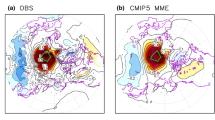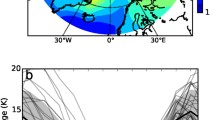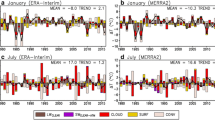Abstract
Temperature inversions are a common feature of the Arctic climate, affecting the surface energy budget and planetary boundary layer transports. This study investigates the evolution of large-scale temperature inversions (between 925 hPa and 2 m) in the context of a changing climate. To this end, two five-member regional climate model (RCM) ensembles, driven by the Canadian Earth System Model, spanning the 1950–2099 period, corresponding to two greenhouse gas emission scenarios (RCP 4.5 and 8.5), are considered. An ERA-Interim driven simulation for the 1979–2005 period is also considered to assess model performance. A comparison of observed atmospheric soundings with the boundary layer variations in the reanalysis-driven simulation indicates that the model captures the temperature inversion characteristics reasonably well, with some positive biases in the temperature inversion strength and frequency. The transient regional climate change simulations suggest substantial decreases in both temperature inversion strength and frequency in winter in future climate for both emission scenarios. These changes are consistent with the reduced sea ice cover and the associated increase in cloud cover that reduce the surface radiative cooling necessary for the formation of strong temperature inversions. Some increases in the frequency and strength of temperature inversions are projected for summer over the Arctic Ocean, possibly linked with increased poleward moisture transport.








Similar content being viewed by others
Data availability
The data presented in this study are available on request from the corresponding author.
Code availability
The code used to generate the plots and to analyze the data can be found at https://github.com/caioruman.
References
AIRS project (2019) Aqua/AIRS L3 daily standard physical retrieval (AIRS+AMSU) 1 degree x 1 degree V7.0, Greenbelt, MD, USA, Goddard Earth Sciences Data and Information Services Center (GES DISC). https://doi.org/10.5067/8XB4RU470FJV
Abraham C, Monahan AH (2019) Climatological features of the weakly and very stably stratified nocturnal boundary layers. Part II: regime occupation and transition statistics and the influence of external drivers. J Atmos Sci 76(11):3485–3504. https://doi.org/10.1175/JAS-D-19-0078.1
Alexander MA, Tomas R, Deser C, Lawrence DM (2010) The atmospheric response to projected terrestrial snow changes in the late twenty-first century. J Clim 23(23):6430–6437. https://doi.org/10.1175/2010JCLI3899.1
Batrak Y, Müller M (2019) On the warm bias in atmospheric reanalyses induced by the missing snow over Arctic sea-ice. Nat Commun 10(1):1–8. https://doi.org/10.1038/s41467-019-11975-3
Bélair S, Mailhot J, Girard C, Vaillancourt P (2005) Boundary layer and shallow cumulus clouds in a medium-range forecast of a large-scale weather system. Mon Weather Rev 133(7):1938–1960. https://doi.org/10.1175/MWR2958.1
Benoit R, Côté J, Mailhot J (1989) Inclusion of a TKE boundary layer parameterization in the Canadian regional finite-element model. Mon Weather Rev 117(8):1726–1750. https://doi.org/10.1175/1520-0493(1989)117%3c1726:Ioatbl%3e2.0.Co;2
Berrisford P, Dee D, Poli P, Brugge R, Fielding K, Fuentes M et al (2011) The ERA-Interim archive, version 2.0. ERA report series. 1. Technical Report. ECMWF, pp 23
Bintanja R, Graversen RG, Hazeleger W (2011) Arctic winter warming amplified by the thermal inversion and consequent low infrared cooling to space. Nat Geosci 4(11):758–761. https://doi.org/10.1038/ngeo1285
Boisvert LN, Stroeve JC (2015) The Arctic is becoming warmer and wetter as revealed by the atmospheric infrared sounder. Geophys Res Lett 42(11):4439–4446. https://doi.org/10.1002/2015GL063775
Bradley RS, Keimig FT, Diaz HF (1992) Climatology of surface-based inversions in the North American Arctic. J Geophys Res 97(D14):15699–15712. https://doi.org/10.1029/92jd01451
Chang L, Feng G, Zhang Y, He X (2018) Effect of cloud fraction on Arctic low-level temperature inversions in AIRS observations over both land and ocean. IEEE Trans Geosci Remote Sens 56(4):2025–2032. https://doi.org/10.1109/TGRS.2017.2772297
Chang L, Wen S, Gao G, Han Z, Feng G, Zhang Y (2021) Assessment of temperature and specific humidity inversions and their relationships in three global reanalysis products over the Arctic Ocean. J Appl Meteorol Climatol 60(4):493–511. https://doi.org/10.1175/JAMC-D-20-0079.1
Chylek P, Li J, Dubey MK, Wang M, Lesins G (2011) Observed and model simulated 20th century Arctic temperature variability: Canadian Earth System Model CanESM2. Atmos Chem Phys Discuss 11(8):22893–22907. https://doi.org/10.5194/acpd-11-22893-2011
Côté J, Gravel S, Méthot A, Patoine A, Roch M, Staniforth A (1998) The operational CMC-MRB global environmental multiscale (GEM) model. Part I: design considerations and formulation. Mon Weather Rev 126(6):1373–1395. https://doi.org/10.1175/1520-0493(1998)126%3c1373:TOCMGE%3e2.0.CO;2
Dee DP, Uppala SM, Simmons AJ, Berrisford P, Poli P, Kobayashi S et al (2011) The ERA-Interim reanalysis: configuration and performance of the data assimilation system. Q J R Meteorol Soc 137(656):553–597. https://doi.org/10.1002/qj.828
Delage Y (1997) Parameterising sub-grid scale vertical transport in atmospheric models under statically stable conditions. Bound-Layer Meteorol 82(1):23–48. https://doi.org/10.1023/a:1000132524077
Delage Y, Girard C (1992) Stability functions correct at the free convection limit and consistent for both the surface and Ekman layers. Bound-Layer Meteorol 58(1):19–31. https://doi.org/10.1007/bf00120749
Deser C, Tomas R, Alexander M, Lawrence D (2010) The seasonal atmospheric response to projected Arctic sea ice loss in the late twenty-first century. J Clim 23(2):333–351. https://doi.org/10.1175/2009JCLI3053.1
Devasthale A, Willén U, Karlsson KG, Jones CG (2010) Quantifying the clear-sky temperature inversion frequency and strength over the Arctic Ocean during summer and winter seasons from AIRS profiles. Atmos Chem Phys 10(12):5565–5572. https://doi.org/10.5194/acp-10-5565-2010
Durre I, Vose RS, Wuertz DB (2006) Overview of the integrated global radiosonde archive. J Clim 19(1):53–68. https://doi.org/10.1175/JCLI3594.1
Fernando HJS, Weil JC (2010) Whither the stable boundary layer? Bull Am Meteor Soc 91(11):1475–1484. https://doi.org/10.1175/2010BAMS2770.1
Fochesatto GJ (2015) Methodology for determining multilayered temperature inversions. Atmos Meas Tech 8(5):2051–2060. https://doi.org/10.5194/amt-8-2051-2015
Gilson G, Jiskoot H, Cassano J, Gultepe I, James T (2018) The thermodynamic structure of Arctic coastal fog occurring during the melt season over east Greenland. Bound-Layer Meteorol 168(3):443–467. https://doi.org/10.1007/s10546-018-0357-3
Gultepe I, Isaac GA, Williams A, Marcotte D, Strawbridge KB (2003) Turbulent heat fluxes over leads and polynyas, and their effects on Arctic clouds during FIRE.ACE: aircraft observations for April 1998. Atmos - Ocean 41(1):15–34. https://doi.org/10.3137/ao.410102
Harris I, Jones PD, Osborn TJ, Lister DH (2014) Updated high-resolution grids of monthly climatic observations - the CRU TS310 dataset. Int J Climatol 34(3):623–642. https://doi.org/10.1002/joc.3711
Hearty TJ, Savtchenko A, Tian B, Fetzer E, Yung YL, Theobald M et al (2014) Estimating sampling biases and measurement uncertainties of AIRS/AMSU-A temperature and water vapor observations using MERRA reanalysis. J Geophys Res 119(6):2725–2741. https://doi.org/10.1002/2013JD021205
Holtslag AAM, Svensson G, Baas P, Basu S, Beare B, Beljaars ACM et al (2013) Stable atmospheric boundary layers and diurnal cycles: challenges for weather and climate models. Bull Am Meteor Soc 94(11):1691–1706. https://doi.org/10.1175/BAMS-D-11-00187.1
Hwang YT, Frierson DMW, Kay JE (2011) Coupling between Arctic feedbacks and changes in poleward energy transport. Geophys Res Lett 38(17): n/a-n/a. https://doi.org/10.1029/2011GL048546
IPCC (2013) Climate change 2013 - the physical science basis. Climate change 2013 - the physical science basis. https://doi.org/10.1017/cbo9781107415324
Kahl JD (1990) Characteristics of the low-level temperature inversion along the Alaskan Arctic coast. Int J Climatol 10(5):537–548. https://doi.org/10.1002/joc.3370100509
Kain JS, Fritsch JM (1990) A one-dimensional entraining/detraining plume model and its application in convective parameterization. J Atmos Sci 47(23):2784–2802. https://doi.org/10.1175/1520-0469(1990)047%3c2784:AODEPM%3e2.0.CO;2
Kim K-Y, Kim J-Y, Kim J, Yeo S, Na H, Hamlington BD, Leben RR (2019) Vertical feedback mechanism of winter Arctic amplification and sea ice loss. Sci Rep 9(1):1184. https://doi.org/10.1038/s41598-018-38109-x
Koenigk T, Brodeau L, Graversen RG, Karlsson J, Svensson G, Tjernström M et al (2013) Arctic climate change in 21st century CMIP5 simulations with EC-Earth. Clim Dyn 40(11–12):2719–2743. https://doi.org/10.1007/s00382-012-1505-y
Koenigk T, Key J, Vihma T (2020) Climate change in the Arctic. In: Kokhanovsky A, Tomasi C (eds) Physics and chemistry of the Arctic atmosphere. Springer Polar Sciences. Springer, Cham. https://doi.org/10.1007/978-3-030-33566-3_11
Kuo HL (1965) On formation and intensification of tropical cyclones through latent heat release by cumulus convection. J Atmos Sci 22(1):40–63. https://doi.org/10.1175/1520-0469(1965)022%3c0040:ofaiot%3e2.0.co;2
Lawrence DM, Slater AG, Tomas RA, Holland MM, Deser C (2008) Accelerated Arctic land warming and permafrost degradation during rapid sea ice loss. Geophys Res Lett 35(11):L11506. https://doi.org/10.1029/2008GL033985
Li J, Barker HW (2005) A radiation algorithm with correlated-k distribution. Part I: local thermal equilibrium. J Atmos Sci 62(2):286–309. https://doi.org/10.1175/JAS-3396.1
Lindsay R, Wensnahan M, Schweiger A, Zhang J (2014) Evaluation of seven different atmospheric reanalysis products in the Arctic. J Clim 27(7):2588–2606. https://doi.org/10.1175/JCLI-D-13-00014.1
Liu Y, Key JR, Schweiger A, Francis J (2006) Characteristics of satellite-derived clear-sky atmospheric temperature inversion strength in the Arctic, 1980–96. J Clim 19(19):4902–4913. https://doi.org/10.1175/JCLI3915.1
Liu Y, Key JR, Liu Z, Wang X, Vavrus SJ (2012) A cloudier Arctic expected with diminishing sea ice. Geophysical Research Letters 39(5):n/a-n/a. https://doi.org/10.1029/2012GL051251
McFarlane NA (1987) The effect of orographically excited gravity wave drag on the general circulation of the lower stratosphere and troposphere. J Atmos Sci 44(14):1775–1800. https://doi.org/10.1175/1520-0469(1987)044%3c1775:teooeg%3e2.0.co;2
Medeiros B, Deser C, Tomas RA, Kay JE (2011) Arctic inversion strength in climate models. J Clim 24(17):4733–4740. https://doi.org/10.1175/2011JCLI3968.1
Mironov D, Rontu L, Kourzeneva E, Terzhevik A (2010) Towards improved representation of lakes in numerical weather prediction and climate models: introduction to the special issue of Boreal Environment Research. Boreal Environ Res 15:97–99
Morrison AL, Kay JE, Frey WR, Chepfer H, Guzman R (2019) Cloud response to Arctic sea ice loss and implications for future feedback in the CESM1 climate model. J Geophy Res: Atmos 124(2):1003–1020. https://doi.org/10.1029/2018JD029142
Palo T, Vihma T, Jaagus J, Jakobson E (2017) Observations of temperature inversions over central Arctic sea ice in summer. Q J R Meteorol Soc 143(708):2741–2754. https://doi.org/10.1002/qj.3123
Pavelsky TM, Boé J, Hall A, Fetzer EJ (2011) Atmospheric inversion strength over polar oceans in winter regulated by sea ice. Clim Dyn 36(5–6):945–955. https://doi.org/10.1007/s00382-010-0756-8
Riahi K, Rao S, Krey V, Cho C, Chirkov V, Fischer G et al (2011) RCP 8.5-a scenario of comparatively high greenhouse gas emissions. Clim Change 109(1):33–57. https://doi.org/10.1007/s10584-011-0149-y
Screen JA, Simmonds I (2010a) Increasing fall-winter energy loss from the Arctic Ocean and its role in Arctic temperature amplification. Geophys Res Lett 37:L16707. https://doi.org/10.1029/2010GL044136
Screen JA, Simmonds I (2010b) The central role of diminishing sea ice in recent Arctic temperature amplification. Nature 464(7293):1334–1337. https://doi.org/10.1038/nature09051
Šeparović L, Alexandru A, Laprise R, Martynov A, Sushama L, Winger K et al (2013) Present climate and climate change over North America as simulated by the fifth-generation Canadian regional climate model. Clim Dyn 41(11–12):3167–3201. https://doi.org/10.1007/s00382-013-1737-5
Serreze MC, Barry RG (2006) The Arctic climate system. Choice Revi Online 44(01):44-0373-44–0373. https://doi.org/10.5860/choice.44-0373
Serreze MC, Barrett AP, Stroeve JC, Kindig DN, Holland MM (2009) The emergence of surface-based Arctic amplification. Cryosphere 3(1):11–19. https://doi.org/10.5194/tc-3-11-2009
Sundqvist H, Berge E, Kristjansson JE (1989) Condensation and cloud parameterization studies with a mesoscale numerical weather prediction model. Mon Weather Rev 117(8):1641–1657. https://doi.org/10.1175/1520-0493(1989)117%3c1641:CACPSW%3e2.0.CO;2
Teufel B, Sushama L (2019) Abrupt changes across the Arctic permafrost region endanger northern development. Nature Publishing Group, Nature Climate Change. https://doi.org/10.1038/s41558-019-0614-6
Tian B, Fetzer EJ, Kahn BH, Teixeira J, Manning E, Hearty T (2013) Evaluating CMIP5 models using AIRS tropospheric air temperature and specific humidity climatology. J Geophys Res Atmos 118(1):114–134. https://doi.org/10.1029/2012JD018607
Tjernström M, Shupe MD, Brooks IM, Achtert P, Prytherch J, Sedlar J (2019) Arctic summer airmass transformation, surface inversions, and the surface energy budget. J Clim 32(3):769–789. https://doi.org/10.1175/JCLI-D-18-0216.1
Van de Wiel BJH, Vignon E, Baas P, van Hooijdonk IGS, van der Linden SJA, van Hooft JA et al (2017) Regime transitions in near-surface temperature inversions: a conceptual model. J Atmos Sci 74(4):1057–1073. https://doi.org/10.1175/JAS-D-16-0180.1
van Vuuren DP, Edmonds J, Kainuma M, Riahi K, Thomson A, Hibbard K et al (2011) The representative concentration pathways: an overview. Clim Change 109(1):5–31. https://doi.org/10.1007/s10584-011-0148-z
Vavrus SJ, Holland MM, Jahn A, Bailey DA, Blazey BA (2012) Twenty-first-century Arctic climate change in CCSM4. J Clim 25(8):2696–2710. https://doi.org/10.1175/JCLI-D-11-00220.1
Verseghy D (2009) CLASS - the Canadian land surface scheme (version 3.4), technical documentation (version 1.1). Climate Research Division, Science and Technology Branch, Environment Canada, Downsview, ON
Wang D, Guo J, Chen A, Bian L, Ding M, Liu L et al (2020) Temperature inversion and clouds over the Arctic Ocean observed by the 5th Chinese National Arctic Research Expedition. J Geophys Res: Atmos 125(13):e2019JD032136. https://doi.org/10.1029/2019JD032136
Wang X, Liu J, Liu H, Bhatt S, Wang M, Wang X et al (2022) Characteristics of Arctic summer inversion and its correlation with extreme sea ice anomalies. Atmosphere 13(2):316. https://doi.org/10.3390/ATMOS13020316
Wetzel C, Brümmer B (2011) An Arctic inversion climatology based on the European Centre Reanalysis ERA-40. Meteorol Z 20(6):589–600. https://doi.org/10.1127/0941-2948/2011/0295
Yeh KS, Côté J, Gravel S, Méthot A, Patoine A, Roch M, Staniforth A (2002) The CMC-MRB global environmental multiscale (GEM) model Part III: nonhydrostatic formulation. Mon Weather Rev 130(2):339–356. https://doi.org/10.1175/1520-0493(2002)130%3c0339:TCMGEM%3e2.0.CO;2
Zadra A, Roch M, Laroche S, Charron M (2003) The subgrid-scale orographic blocking parametrization of the GEM model. Atmos Ocean 41(2):155–170. https://doi.org/10.3137/ao.410204
Zhang Y, Seidel DJ, Golaz JC, Deser C, Tomas RA (2011) Climatological characteristics of Arctic and Antarctic surface-based inversions. J Clim 24(19):5167–5186. https://doi.org/10.1175/2011JCLI4004.1
Zhang L, Li J, Ding M, Guo J, Bian L, Sun Q et al (2021) Characteristics of low-level temperature inversions over the Arctic Ocean during the CHINARE 2018 campaign in summer. Atmos Environ 253:118333. https://doi.org/10.1016/j.atmosenv.2021.118333
Zhang L, Ding M, Dou T, Huang Y, Lv J, Xiao C (2021) The shallowing surface temperature inversions in the Arctic. J Clim 34(10):4159–4168. https://doi.org/10.1175/JCLI-D-20-0621.1
Zhang Y, Seidel DJ (2011) Challenges in estimating trends in Arctic surface-based inversions from radiosonde data. Geophys Res Lett 38(17):n/a-n/a. https://doi.org/10.1029/2011GL048728
Acknowledgements
CJR acknowledges the support of the McGill Engineering Doctoral Awards (MEDA) program. The GEM simulations in this study were performed on supercomputers managed by Calcul Québec and Compute Canada.
Funding
This work was supported by funding from the Marine Environmental Observation, Prediction, and Response (MEOPAR)/Polar Knowledge Canada (POLAR) Year of Polar Prediction project “Predicting the Future(s) of Renewable Energy in Canada’s Arctic.” AHM acknowledges the support of the Natural Sciences and Engineering Research Council of Canada (NSERC) [funding reference number RGPIN-2019–04986].
Author information
Authors and Affiliations
Contributions
C. J. Ruman analyzed the data and wrote the manuscript with editorial assistance from L. Sushama and A. Monahan.
Corresponding author
Ethics declarations
Ethics approval
Not applicable.
Consent to participate.
Not applicable.
Consent for publication.
Not applicable.
Competing interests
The authors declare no competing interests.
Additional information
Publisher's note
Springer Nature remains neutral with regard to jurisdictional claims in published maps and institutional affiliations.
Supplementary Information
Below is the link to the electronic supplementary material.
Rights and permissions
Springer Nature or its licensor holds exclusive rights to this article under a publishing agreement with the author(s) or other rightsholder(s); author self-archiving of the accepted manuscript version of this article is solely governed by the terms of such publishing agreement and applicable law.
About this article
Cite this article
Ruman, C.J., Monahan, A.H. & Sushama, L. Climatology of Arctic temperature inversions in current and future climates. Theor Appl Climatol 150, 121–134 (2022). https://doi.org/10.1007/s00704-022-04147-9
Received:
Accepted:
Published:
Issue Date:
DOI: https://doi.org/10.1007/s00704-022-04147-9




